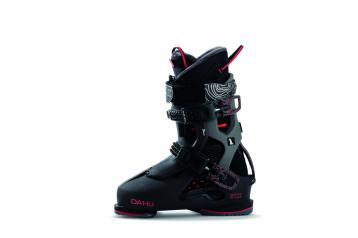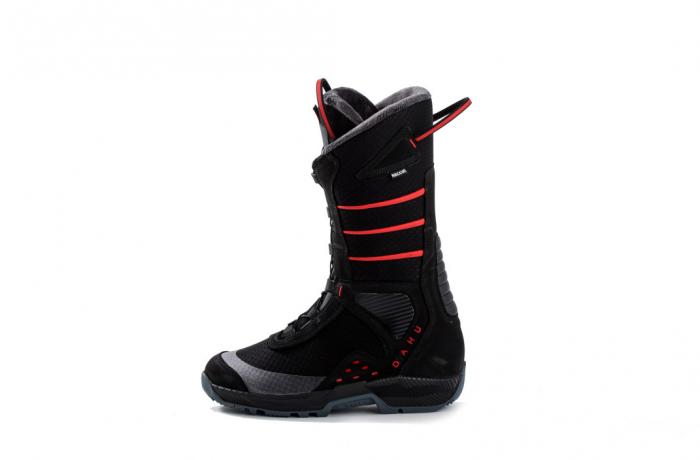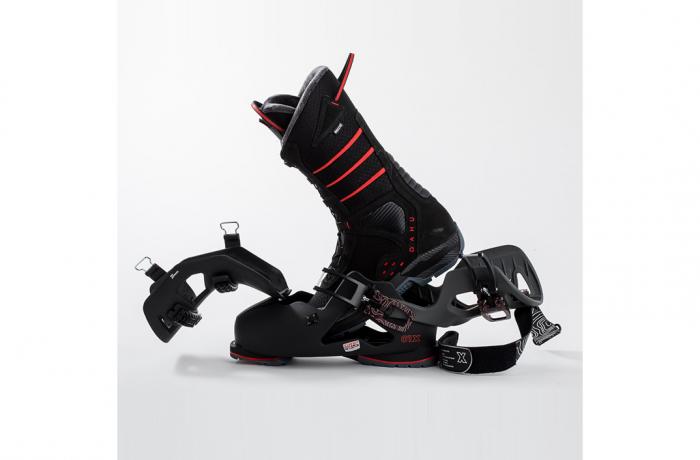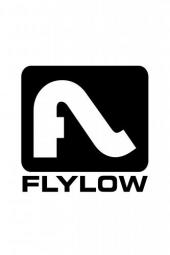While the Dahu boot (based in Switzerland) was released in the North American market just before the Covid pandemic, this was our first chance to test the boots and according to Dahu they are treating the 2022-23 winter season as a re-introduction of the product now that things are returning to a bit more normal program.
The Ecorce 01X in the 135 flex option is Dahu's top-shelf, flagship model, though due to the stiff flex it is not their best-selling nor most-available model for try-on at dealer locations. We tested it in the Frontside category alongside two perennial Frontside favorites in 130 and 140 flexes to see whether it would sink or swim. Our test team was at first surprised that it didn't drown, and then they were shocked that the Ecorce 01X 135 was swimming laps pretty well alongside the other benchmark models. By the end of the ten-day test period and many individual tests on the boot our test team was left shaking its collective head over how well the newcomer had held its own against the industry's best. Did it win the category? Not by a substantial margin, no, but it wasn't out of place (so long as you didn't look down) and it scored well enough to earn a silver medal. Bravo Dahu!
There's a lot to unpack when covering a brand-new model and especially so with a design as unique as this is. Let's start by not unpacking the liner from the shell--while you could unpack it (and marching around in the closely fitted, long lace system liner is an apres warrior's dream come true), it is not the easiest way to get into and out of the boot, which is hands-down one of the very best features of the Dahu system. With the liner loaded into the shell and its rearward hinging cuff locked into normal skiing position but the forward external tongue (it is a three-piece design) released forward and out of the way it's ready to suck in some foot. And it does! With the long lace system (many eyelets and lots of slack and a lace lock) completely loosened up, the slide into the boot is easier than any other boot on the market, period. Same with getting it off, release the shell's external tongue, loosen the liner's lace system and bam, you're outta there. This entry and exit protocol is the way for skiers who intend to use it like a traditional boot: get to hill, put on boot, ski, take off boot when done, leave. However, for those who want to deploy its secret apres ski weapon or enable a rapid switch from skiing to driving, the rear portion of the shell can be released as well and the liner (with foot) can be pulled out easily. Getting the liner (with foot) into the shell system is a little trickier but with some practice it's accomplished, and done so most easily while seated.
But how does it ski? Well, let's talk about how it flexes first, as that is the second most important thing about the Dahu boot--the combination of the tallish feeling liner tongue and highly tunable lacing tension there enables a well-distributed fit along the shin that oozes comfort, but in a snug and firmly cushioned way. Then, coupled with the characteristically even flex feel of the three piece shell construction the fore-aft movements in this boot are natural and comfortable in a way often not felt in more traditional designs. While the 135 flex we tested in the Frontside category offered appropriately limited range of flexion (it's a legit 135, or stronger) you still felt the liner and shell working together well. The 120 flex we tested in the All-Mountain Traditional category amplified this positive element.
It does ski quite well, according to testers who were surprised at the level of power that the Dahu generated and the stability the 135 flex offered at high speeds and on hard snow. The inner boot is mated to the shell with very close tolerances and the inner boot is not a mushy moccasin, so transmission of movement and energy was direct and accurate, testers said. The common complaints that several testers mentioned were related to stance. The out-of-box geometry is slightly more upright than the current norm, and the lateral set-up is a little softer to the inside edge than most. The fore-aft issue is easily solved with an in-box offset bushing that can be swapped onto the rear cuff which tips it into a more forward position that most testers preferred. The lateral issue is remedied with material glued to the medial aspect of the shell, essentially filling the gap between the liner and shell since there is no lateral cuff adjustment mechanism offered on the boot. Testers also notice that the boot sole runs longer than traditional boots of the same size--not by a lot, but by enough that it's noticeable when walking and will certainly require adjusting or re-mounting bindings for skiers making a boot switch but keeping their ski and binding set up as is.
What about bootfitting options, testers wondered? There aren't many fitting features outside of minor in-liner tweaks and liner heat molding. There's a possibility of a little grind or gentle stretch in certain spots, but this is not what the boot is really designed for. It's designed to fit well out of the box for the average foot shape, but it happens to fit extremely well for the typical foot's trouble spots. Testers who normally require forefoot expansion or ankle bone punches cited that the Dahu fit those areas nicely in its stock set-up. Testers' advice to customers is to be satisfied with the boot's fit as it is when considering a purchase, not a fit that could be.









Kudos
Caveats